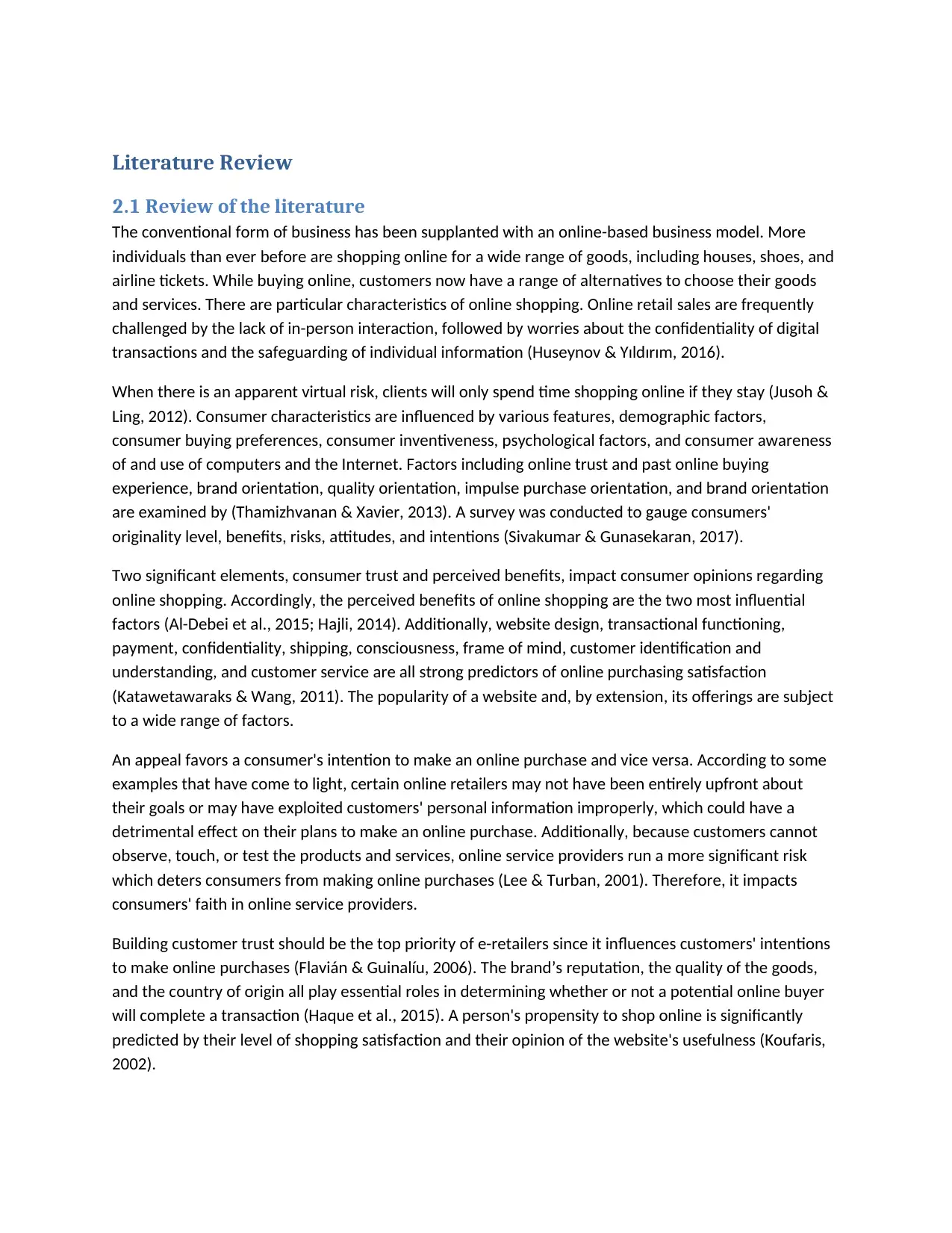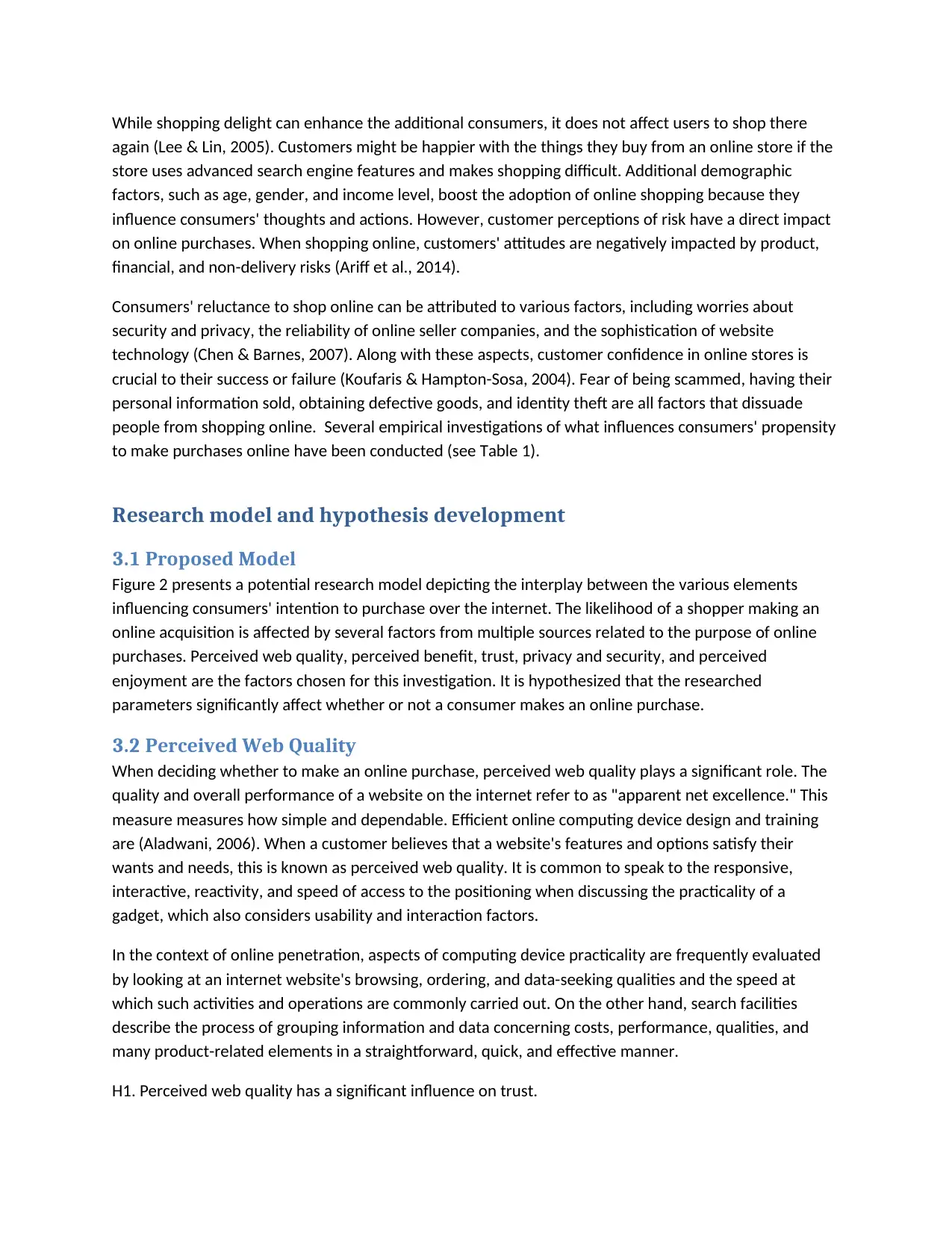Reviewing Factors Influencing Consumers' Online Purchase Intention
VerifiedAdded on 2023/07/14
|3
|1116
|210
Literature Review
AI Summary
This literature review explores the shift from traditional business models to online platforms and the factors influencing consumers' online purchase intentions. It highlights the challenges of online retail, such as the lack of in-person interaction and concerns about transaction security, and examines various consumer characteristics, including demographic factors, buying preferences, and psychological influences. The review emphasizes the importance of consumer trust, perceived benefits, and website design in shaping online shopping satisfaction. It also discusses the impact of perceived web quality, privacy, security, and enjoyment on consumers' intention to purchase online, proposing a research model to illustrate these relationships. Ultimately, the review underscores the need for e-retailers to prioritize building customer trust and providing a seamless online shopping experience to foster positive consumer attitudes and drive online purchases. Desklib provides solved assignments for students.

Literature Review
2.1 Review of the literature
The conventional form of business has been supplanted with an online-based business model. More
individuals than ever before are shopping online for a wide range of goods, including houses, shoes, and
airline tickets. While buying online, customers now have a range of alternatives to choose their goods
and services. There are particular characteristics of online shopping. Online retail sales are frequently
challenged by the lack of in-person interaction, followed by worries about the confidentiality of digital
transactions and the safeguarding of individual information (Huseynov & Yıldırım, 2016).
When there is an apparent virtual risk, clients will only spend time shopping online if they stay (Jusoh &
Ling, 2012). Consumer characteristics are influenced by various features, demographic factors,
consumer buying preferences, consumer inventiveness, psychological factors, and consumer awareness
of and use of computers and the Internet. Factors including online trust and past online buying
experience, brand orientation, quality orientation, impulse purchase orientation, and brand orientation
are examined by (Thamizhvanan & Xavier, 2013). A survey was conducted to gauge consumers'
originality level, benefits, risks, attitudes, and intentions (Sivakumar & Gunasekaran, 2017).
Two significant elements, consumer trust and perceived benefits, impact consumer opinions regarding
online shopping. Accordingly, the perceived benefits of online shopping are the two most influential
factors (Al-Debei et al., 2015; Hajli, 2014). Additionally, website design, transactional functioning,
payment, confidentiality, shipping, consciousness, frame of mind, customer identification and
understanding, and customer service are all strong predictors of online purchasing satisfaction
(Katawetawaraks & Wang, 2011). The popularity of a website and, by extension, its offerings are subject
to a wide range of factors.
An appeal favors a consumer's intention to make an online purchase and vice versa. According to some
examples that have come to light, certain online retailers may not have been entirely upfront about
their goals or may have exploited customers' personal information improperly, which could have a
detrimental effect on their plans to make an online purchase. Additionally, because customers cannot
observe, touch, or test the products and services, online service providers run a more significant risk
which deters consumers from making online purchases (Lee & Turban, 2001). Therefore, it impacts
consumers' faith in online service providers.
Building customer trust should be the top priority of e-retailers since it influences customers' intentions
to make online purchases (Flavián & Guinalíu, 2006). The brand’s reputation, the quality of the goods,
and the country of origin all play essential roles in determining whether or not a potential online buyer
will complete a transaction (Haque et al., 2015). A person's propensity to shop online is significantly
predicted by their level of shopping satisfaction and their opinion of the website's usefulness (Koufaris,
2002).
2.1 Review of the literature
The conventional form of business has been supplanted with an online-based business model. More
individuals than ever before are shopping online for a wide range of goods, including houses, shoes, and
airline tickets. While buying online, customers now have a range of alternatives to choose their goods
and services. There are particular characteristics of online shopping. Online retail sales are frequently
challenged by the lack of in-person interaction, followed by worries about the confidentiality of digital
transactions and the safeguarding of individual information (Huseynov & Yıldırım, 2016).
When there is an apparent virtual risk, clients will only spend time shopping online if they stay (Jusoh &
Ling, 2012). Consumer characteristics are influenced by various features, demographic factors,
consumer buying preferences, consumer inventiveness, psychological factors, and consumer awareness
of and use of computers and the Internet. Factors including online trust and past online buying
experience, brand orientation, quality orientation, impulse purchase orientation, and brand orientation
are examined by (Thamizhvanan & Xavier, 2013). A survey was conducted to gauge consumers'
originality level, benefits, risks, attitudes, and intentions (Sivakumar & Gunasekaran, 2017).
Two significant elements, consumer trust and perceived benefits, impact consumer opinions regarding
online shopping. Accordingly, the perceived benefits of online shopping are the two most influential
factors (Al-Debei et al., 2015; Hajli, 2014). Additionally, website design, transactional functioning,
payment, confidentiality, shipping, consciousness, frame of mind, customer identification and
understanding, and customer service are all strong predictors of online purchasing satisfaction
(Katawetawaraks & Wang, 2011). The popularity of a website and, by extension, its offerings are subject
to a wide range of factors.
An appeal favors a consumer's intention to make an online purchase and vice versa. According to some
examples that have come to light, certain online retailers may not have been entirely upfront about
their goals or may have exploited customers' personal information improperly, which could have a
detrimental effect on their plans to make an online purchase. Additionally, because customers cannot
observe, touch, or test the products and services, online service providers run a more significant risk
which deters consumers from making online purchases (Lee & Turban, 2001). Therefore, it impacts
consumers' faith in online service providers.
Building customer trust should be the top priority of e-retailers since it influences customers' intentions
to make online purchases (Flavián & Guinalíu, 2006). The brand’s reputation, the quality of the goods,
and the country of origin all play essential roles in determining whether or not a potential online buyer
will complete a transaction (Haque et al., 2015). A person's propensity to shop online is significantly
predicted by their level of shopping satisfaction and their opinion of the website's usefulness (Koufaris,
2002).
Paraphrase This Document
Need a fresh take? Get an instant paraphrase of this document with our AI Paraphraser

While shopping delight can enhance the additional consumers, it does not affect users to shop there
again (Lee & Lin, 2005). Customers might be happier with the things they buy from an online store if the
store uses advanced search engine features and makes shopping difficult. Additional demographic
factors, such as age, gender, and income level, boost the adoption of online shopping because they
influence consumers' thoughts and actions. However, customer perceptions of risk have a direct impact
on online purchases. When shopping online, customers' attitudes are negatively impacted by product,
financial, and non-delivery risks (Ariff et al., 2014).
Consumers' reluctance to shop online can be attributed to various factors, including worries about
security and privacy, the reliability of online seller companies, and the sophistication of website
technology (Chen & Barnes, 2007). Along with these aspects, customer confidence in online stores is
crucial to their success or failure (Koufaris & Hampton-Sosa, 2004). Fear of being scammed, having their
personal information sold, obtaining defective goods, and identity theft are all factors that dissuade
people from shopping online. Several empirical investigations of what influences consumers' propensity
to make purchases online have been conducted (see Table 1).
Research model and hypothesis development
3.1 Proposed Model
Figure 2 presents a potential research model depicting the interplay between the various elements
influencing consumers' intention to purchase over the internet. The likelihood of a shopper making an
online acquisition is affected by several factors from multiple sources related to the purpose of online
purchases. Perceived web quality, perceived benefit, trust, privacy and security, and perceived
enjoyment are the factors chosen for this investigation. It is hypothesized that the researched
parameters significantly affect whether or not a consumer makes an online purchase.
3.2 Perceived Web Quality
When deciding whether to make an online purchase, perceived web quality plays a significant role. The
quality and overall performance of a website on the internet refer to as "apparent net excellence." This
measure measures how simple and dependable. Efficient online computing device design and training
are (Aladwani, 2006). When a customer believes that a website's features and options satisfy their
wants and needs, this is known as perceived web quality. It is common to speak to the responsive,
interactive, reactivity, and speed of access to the positioning when discussing the practicality of a
gadget, which also considers usability and interaction factors.
In the context of online penetration, aspects of computing device practicality are frequently evaluated
by looking at an internet website's browsing, ordering, and data-seeking qualities and the speed at
which such activities and operations are commonly carried out. On the other hand, search facilities
describe the process of grouping information and data concerning costs, performance, qualities, and
many product-related elements in a straightforward, quick, and effective manner.
H1. Perceived web quality has a significant influence on trust.
again (Lee & Lin, 2005). Customers might be happier with the things they buy from an online store if the
store uses advanced search engine features and makes shopping difficult. Additional demographic
factors, such as age, gender, and income level, boost the adoption of online shopping because they
influence consumers' thoughts and actions. However, customer perceptions of risk have a direct impact
on online purchases. When shopping online, customers' attitudes are negatively impacted by product,
financial, and non-delivery risks (Ariff et al., 2014).
Consumers' reluctance to shop online can be attributed to various factors, including worries about
security and privacy, the reliability of online seller companies, and the sophistication of website
technology (Chen & Barnes, 2007). Along with these aspects, customer confidence in online stores is
crucial to their success or failure (Koufaris & Hampton-Sosa, 2004). Fear of being scammed, having their
personal information sold, obtaining defective goods, and identity theft are all factors that dissuade
people from shopping online. Several empirical investigations of what influences consumers' propensity
to make purchases online have been conducted (see Table 1).
Research model and hypothesis development
3.1 Proposed Model
Figure 2 presents a potential research model depicting the interplay between the various elements
influencing consumers' intention to purchase over the internet. The likelihood of a shopper making an
online acquisition is affected by several factors from multiple sources related to the purpose of online
purchases. Perceived web quality, perceived benefit, trust, privacy and security, and perceived
enjoyment are the factors chosen for this investigation. It is hypothesized that the researched
parameters significantly affect whether or not a consumer makes an online purchase.
3.2 Perceived Web Quality
When deciding whether to make an online purchase, perceived web quality plays a significant role. The
quality and overall performance of a website on the internet refer to as "apparent net excellence." This
measure measures how simple and dependable. Efficient online computing device design and training
are (Aladwani, 2006). When a customer believes that a website's features and options satisfy their
wants and needs, this is known as perceived web quality. It is common to speak to the responsive,
interactive, reactivity, and speed of access to the positioning when discussing the practicality of a
gadget, which also considers usability and interaction factors.
In the context of online penetration, aspects of computing device practicality are frequently evaluated
by looking at an internet website's browsing, ordering, and data-seeking qualities and the speed at
which such activities and operations are commonly carried out. On the other hand, search facilities
describe the process of grouping information and data concerning costs, performance, qualities, and
many product-related elements in a straightforward, quick, and effective manner.
H1. Perceived web quality has a significant influence on trust.

H2. Perceived web quality has a positive impact on online purchase intention.
⊘ This is a preview!⊘
Do you want full access?
Subscribe today to unlock all pages.

Trusted by 1+ million students worldwide
1 out of 3
Related Documents
Your All-in-One AI-Powered Toolkit for Academic Success.
+13062052269
info@desklib.com
Available 24*7 on WhatsApp / Email
![[object Object]](/_next/static/media/star-bottom.7253800d.svg)
Unlock your academic potential
Copyright © 2020–2025 A2Z Services. All Rights Reserved. Developed and managed by ZUCOL.




